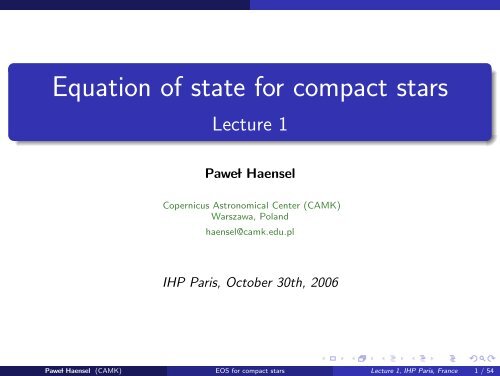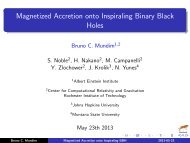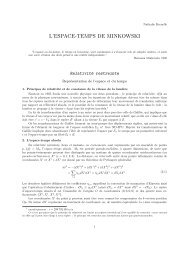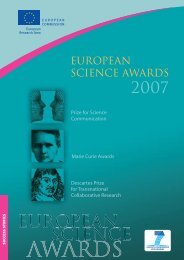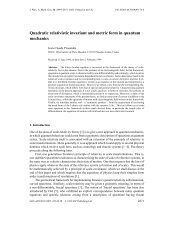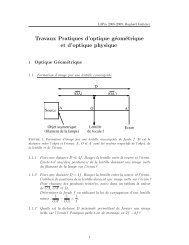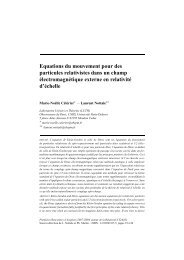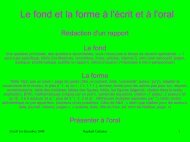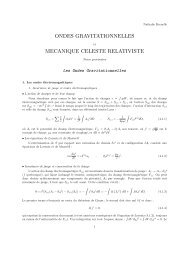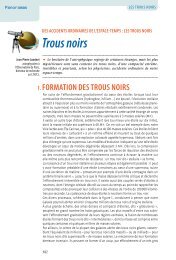Equation of state for compact stars Lecture 1 - LUTh
Equation of state for compact stars Lecture 1 - LUTh
Equation of state for compact stars Lecture 1 - LUTh
Create successful ePaper yourself
Turn your PDF publications into a flip-book with our unique Google optimized e-Paper software.
<strong>Equation</strong> <strong>of</strong> <strong>state</strong> <strong>for</strong> <strong>compact</strong> <strong>stars</strong><br />
<strong>Lecture</strong> 1<br />
Pawe̷l Haensel<br />
Copernicus Astronomical Center (CAMK)<br />
Warszawa, Poland<br />
haensel@camk.edu.pl<br />
IHP Paris, October 30th, 2006<br />
Pawe̷l Haensel (CAMK) EOS <strong>for</strong> <strong>compact</strong> <strong>stars</strong> <strong>Lecture</strong> 1, IHP Paris, France 1 / 54
Anticipation and prediction <strong>of</strong> neutron <strong>stars</strong><br />
Anticipation - Landau February 1931<br />
Widely known facts: Neutron discovered by J. Chadwick -<br />
Jan.1932, published in Nature on February 27, 1932<br />
(Chadwick 1932). A year be<strong>for</strong>e Chadwick paper -<br />
Lev Landau had written a paper devoted to dense<br />
<strong>stars</strong>! Landau (23 at that time, graduate student <strong>of</strong> the<br />
Leningrad Physico-Technical Institute). Paper completed<br />
in February 1931 in Zürich, where Landau visited Pauli<br />
(Landau 1932). First part: brilliant (independent <strong>of</strong><br />
Chandrasekhar) derivation <strong>of</strong> the mass limit <strong>for</strong> white<br />
dwarfs. Last part: <strong>for</strong> <strong>stars</strong> heavier than 1.5M⊙ “the<br />
density <strong>of</strong> matter becomes so great that atomic nuclei<br />
come in close contact, <strong>for</strong>ming one gigantic nucleus.”=⇒<br />
correct description <strong>of</strong> dense matter in neutron star<br />
interiors, given be<strong>for</strong>e the discovery <strong>of</strong> the neutron.<br />
Pawe̷l Haensel (CAMK) EOS <strong>for</strong> <strong>compact</strong> <strong>stars</strong> <strong>Lecture</strong> 1, IHP Paris, France 2 / 54
Anticipation and prediction <strong>of</strong> neutron <strong>stars</strong> - cont.<br />
Prediction - Baade and Zwicky December 1933<br />
W. Baade (Mt. Wilson Observatory) and F. Zwicky (Caltech) analyzed<br />
observations <strong>of</strong> supernova explosions and proposed an explanation <strong>of</strong> an enormous<br />
energy release in these explosions. Results presented at the meeting <strong>of</strong> the<br />
American Physical Society at Stan<strong>for</strong>d (December 15–16, 1933) and published in<br />
the 15 January issue <strong>of</strong> the Physical Review (Baade & Zwicky 1933) “With all<br />
reserve we advance the view that supernovae represent the transitions from<br />
ordinary <strong>stars</strong> to neutron <strong>stars</strong>, which in their final stages consist <strong>of</strong> extremely<br />
closely packed neutrons.”<br />
A brief summary <strong>of</strong> the neutron star prediction was presented to non-expert readers in<br />
the <strong>for</strong>m <strong>of</strong> a cartoon in the Los Angeles Times on January 19th, 1934: “Cosmic rays are<br />
caused by exploding <strong>stars</strong> which burn with a fire equal to 100 million suns and then<br />
shrivel from 1/2 million mile diameters to little spheres 14 miles thick, says Pr<strong>of</strong>. Fritz<br />
Zwicky, Swiss Physicist.”<br />
Pawe̷l Haensel (CAMK) EOS <strong>for</strong> <strong>compact</strong> <strong>stars</strong> <strong>Lecture</strong> 1, IHP Paris, France 3 / 54
Neutron star interior: known and unknown<br />
Plan<br />
White dwarfs and neutron star<br />
envelopes<br />
Neutron star crusts<br />
Neutron star cores: nucleons<br />
and hyperons<br />
Briefly - exotic neutron star<br />
cores, quark <strong>stars</strong>, etc.<br />
Briefly - confronting EOS<br />
models with mesured neutron<br />
star masses<br />
Standard reference: S.L. Shapiro, S.A. Teukolsky Black Holes, White Dwarfs, and<br />
Neutron Stars: The Physics <strong>of</strong> Compact Objects (Wiley, 1983). Alas, 23-years old.<br />
New advanced reference available soon: P. Haensel, A.Y. Potekhin, and D.G. Yakovlev<br />
Neutron Stars 1. <strong>Equation</strong> <strong>of</strong> <strong>state</strong> and structure (Springer, January 2007)<br />
Pawe̷l Haensel (CAMK) EOS <strong>for</strong> <strong>compact</strong> <strong>stars</strong> <strong>Lecture</strong> 1, IHP Paris, France 4 / 54
EOS - an overview<br />
EOS <strong>of</strong> neutron star matter at<br />
T = 0: Baym et al. (1971)<br />
(triangles), Haensel & Pichon<br />
(1994)(HP94, <strong>stars</strong>), SLy -<br />
Douchin & Haensel (2001) (dots).<br />
Finite T EOSs: OPAL (Rogers et<br />
al. 1996) at T = 10 6 , 10 7 , and<br />
10 8 K (dashed lines), the fit<br />
(Haensel & Potekhin 2004)(the<br />
solid line) and the fit modified at<br />
low ρ (the dotted line). From<br />
Haensel & Potekhin (2004).<br />
For ρ > 10 6 g cm −3 T -effects<br />
invisible - matter fully degenerate,<br />
T = 0 approximation <strong>for</strong> the EOS<br />
is valid.<br />
Pawe̷l Haensel (CAMK) EOS <strong>for</strong> <strong>compact</strong> <strong>stars</strong> <strong>Lecture</strong> 1, IHP Paris, France 5 / 54
Structure <strong>of</strong> envelope and crust<br />
Schematic structure <strong>of</strong> an envelope <strong>of</strong> a neutron star with the internal<br />
temperature ∼ 10 8 K.<br />
Pawe̷l Haensel (CAMK) EOS <strong>for</strong> <strong>compact</strong> <strong>stars</strong> <strong>Lecture</strong> 1, IHP Paris, France 6 / 54
Plasma parameters<br />
Outer envelope: one kind <strong>of</strong> nuclei (fully ionized atoms) (A, Z), A = N + Z. This<br />
is an approximation - one component plasma (OCP). Mean number density <strong>of</strong><br />
nuclei (=ions) n N . (If several j-species <strong>of</strong> nuclei are present then mean number<br />
density <strong>of</strong> nuclei n N = <br />
j nj.) Electron mean number density ne = Zn N .<br />
Outer envelope, outer crust: all nucleons bound in nuclei =⇒ mean nucleon<br />
(=baryon) number density nb = A n N<br />
Inner envelope, inner crust nb = A ′ n N where A ′ ≡ A + A ′′ . Here A ′′ is the<br />
number <strong>of</strong> free (unbound) nucleons per one atomic nucleus. We have<br />
A ′′ n N = nn (1 − w), where w is the fraction <strong>of</strong> volume occupied by atomic nuclei.<br />
Outer envelope A ′ = A, inner envelope A ′ > A.<br />
Mass density ρ = E/c 2 , but in the envelope and crust ρ ≈ munb, where<br />
mu = 1.6605 × 10 −24 g is the atomic mass unit.<br />
Pawe̷l Haensel (CAMK) EOS <strong>for</strong> <strong>compact</strong> <strong>stars</strong> <strong>Lecture</strong> 1, IHP Paris, France 7 / 54
Electrons<br />
Relativity parameter (<strong>of</strong>ten used instead <strong>of</strong> ne)<br />
xr ≡ pF<br />
<br />
ρ6〈Z〉<br />
≈ 1.00884<br />
mec A ′<br />
1/3 , (1)<br />
where<br />
pF = kF = (3π 2 ne) 1/3 , (2)<br />
is the electron Fermi momentum and ρ6 ≡ ρ/106 g cm−3 . The Fermi energy<br />
ɛF = c 2<br />
<br />
(mec) 2 + p2 F<br />
Notice: electron rest energy mec 2 is included. The electron Fermi temperature is<br />
where<br />
(3)<br />
TF = Tr (γr − 1) , (4)<br />
Tr = mec 2 /kB ≈ 5.930 × 10 9 K (5)<br />
is the relativistic temperature unit, γr = √ 1 + xr 2 , and kB is the Boltzmann<br />
constant. The electron gas is non-relativistic at T ≪ Tr and xr ≪ 1, and it is<br />
ultrarelativistic at xr ≫ 1 or T ≫ Tr. It is nondegenerate at T ≫ TF and strongly<br />
degenerate at T ≪ TF.<br />
Pawe̷l Haensel (CAMK) EOS <strong>for</strong> <strong>compact</strong> <strong>stars</strong> <strong>Lecture</strong> 1, IHP Paris, France 8 / 54
Electrons - continued<br />
The density or temperature are called relativistic if the respective parameter xr or<br />
tr = T/Tr<br />
is large (> 1). The electron Fermi velocity vF = ∂ɛF/∂pF.<br />
One introduces electron-sphere radius = radius <strong>of</strong> a sphere <strong>of</strong> volume equal to a<br />
volume per one electron = V/Ne = 1/ne ,<br />
(6)<br />
ae = [3/(4πne)] 1/3 . (7)<br />
Pawe̷l Haensel (CAMK) EOS <strong>for</strong> <strong>compact</strong> <strong>stars</strong> <strong>Lecture</strong> 1, IHP Paris, France 9 / 54
Electrons - continued<br />
The strength <strong>of</strong> the electron Coulomb interaction in a plasma <strong>of</strong> nondegenerate<br />
electrons can be characterized by the electron Coulomb coupling parameter<br />
Γe = e2<br />
aekBT<br />
≈ 22.75<br />
T6<br />
<br />
ρ6<br />
Z<br />
A ′<br />
1/3 , (8)<br />
where T6 ≡ T/106 K. We shall use this parameter Γe <strong>for</strong> any plasma conditions<br />
though Γe has no transparent physical meaning <strong>for</strong> degenerate electrons.<br />
For further use, it is convenient to introduce the electron plasma temperature<br />
Tpe = ωpe/kB ≈ 3.300 × 10 8 <br />
xr βr K . (9)<br />
where βr = vF/c and electron plasma frequency is given by<br />
ωpe = 4πe 2 ne/m ∗1/2 e<br />
Here, m ∗ e ≡ ɛF/c 2 = meγr is the effective dynamical mass <strong>of</strong> an electron at the<br />
Fermi surface. Perturbations <strong>of</strong> electron density oscillate with a frequency ωpe - see Landau & Lifshitz Stat. Phys. 1, Physical Kinetics<br />
(10)<br />
Pawe̷l Haensel (CAMK) EOS <strong>for</strong> <strong>compact</strong> <strong>stars</strong> <strong>Lecture</strong> 1, IHP Paris, France 10 / 54
ni = nN<br />
Ions<br />
The strength <strong>of</strong> the Coulomb interaction <strong>of</strong> ions is characterized by the Coulomb<br />
coupling parameter,<br />
Γ = ΓeZ 5/3 = (Ze) 2 /(aikBT ), (11)<br />
where<br />
is the ion-sphere radius.<br />
ai = aeZ 1/3 = (3ni/4π) 1/3<br />
At sufficiently high temperatures, the ions <strong>for</strong>m a classical Boltzmann gas. With<br />
decreasing T , the gas gradually, without a phase transition, becomes a strongly<br />
coupled Coulomb liquid, and then (with a phase transition) a Coulomb crystal.<br />
The gas and liquid constitute the neutron star ocean, while the crystal is <strong>for</strong>med<br />
under the ocean.<br />
(12)<br />
Pawe̷l Haensel (CAMK) EOS <strong>for</strong> <strong>compact</strong> <strong>stars</strong> <strong>Lecture</strong> 1, IHP Paris, France 11 / 54
Ions - continued<br />
The gaseous regime <strong>of</strong> an OCP occurs <strong>for</strong> Γ ≪ 1, or T ≫ Tl, where<br />
Tl = Z2 e 2<br />
aikB<br />
≈ 2.275 × 10 7 Z 2 ρ6<br />
A ′<br />
1/3 K. (13)<br />
Important feature: For a plasma <strong>of</strong> light elements (H, He,C) one has Tl < TF,<br />
whereas <strong>for</strong> heavy elements (Fe, Ni, etc.) Tl TF.<br />
The ion-sphere radius ai, defined by Eq. (12), is the main ingredient <strong>of</strong> the<br />
ion-sphere model <strong>for</strong> strongly coupled Coulomb systems (T Tl) with nearly<br />
uni<strong>for</strong>m electron background. In this model the matter is considered as an<br />
ensemble <strong>of</strong> ion spheres filled by the uni<strong>for</strong>m electron background. It is supposed<br />
that any ion sphere contains an ion in its center. The radius ai is chosen in such a<br />
way that electron charge within the sphere compensates the ion charge. Then the<br />
spheres are electrically neutral and can be treated as non-interacting between<br />
themselves.<br />
Pawe̷l Haensel (CAMK) EOS <strong>for</strong> <strong>compact</strong> <strong>stars</strong> <strong>Lecture</strong> 1, IHP Paris, France 12 / 54
Ions - continued<br />
The scale-length that characterizes quantum-mechanical effects on<br />
thermodynamics <strong>of</strong> liquid and gaseous phases is the ion thermal (de Broglie)<br />
wavelength<br />
2 2π<br />
λi =<br />
mikBT<br />
1/2<br />
, (14)<br />
where mi is the ion (nucleus) mass. In the following, we shall also use also<br />
electron thermal wavelength λe, given by Eq. (14) with mi replaced by me.<br />
Pawe̷l Haensel (CAMK) EOS <strong>for</strong> <strong>compact</strong> <strong>stars</strong> <strong>Lecture</strong> 1, IHP Paris, France 13 / 54
Ions - continued<br />
The crystallization <strong>of</strong> a Coulomb plasma occurs at a well defined temperature<br />
Tm = Z2 e 2<br />
aikBΓm<br />
≈ 1.3 × 10 5 Z 2 ρ6<br />
A ′<br />
1/3 175<br />
Γm<br />
K, (15)<br />
where Γm is the ”melting value” <strong>of</strong> Γ. For a classical OCP, Γm ≈ 175.<br />
At low T the quantum effects on ion motion become important. They are<br />
especially pronounced at T ≪ Tpi, where<br />
Tpi ≡ ωpi<br />
kB<br />
≈ 7.832 × 10 6<br />
<br />
ρ6<br />
A ′<br />
Z2 1/2<br />
A<br />
K (16)<br />
is the plasma temperature <strong>of</strong> ions determined by the ion plasma frequency<br />
ωpi = 4πe 2 niZ 2 1/2 /mi . (17)<br />
If Tpi ≫ Tm, huge zero-point ion vibrations suppress crystallization and reduce the<br />
melting temperature. Under these conditions, the actual melting temperature<br />
decreases with growing ρ and drops to zero at a certain ρ = ρm.<br />
Pawe̷l Haensel (CAMK) EOS <strong>for</strong> <strong>compact</strong> <strong>stars</strong> <strong>Lecture</strong> 1, IHP Paris, France 14 / 54
ρ − T diagram <strong>for</strong> the outer envelope<br />
Density-temperature diagram <strong>for</strong> the outer envelope composed <strong>of</strong> carbon (left) or iron<br />
(right). Electron Fermi temperature (TF), electron and ion plasma temperatures (Tpe<br />
and Tpi), temperature <strong>of</strong> the gradual gas-liquid transition (Tl), and the temperature <strong>of</strong><br />
the sharp liquid-solid phase transition (Tm). Shaded: typical temperatures in the outer<br />
envelopes <strong>of</strong> middle-aged cooling neutron <strong>stars</strong> (age ∼ 10 4 − 10 6 ). Corner bounded by the dotted line:<br />
strong electron non-uni<strong>for</strong>mity or bound-<strong>state</strong> <strong>for</strong>mation (atoms!) in the iron plasma. Difficult region!<br />
Pawe̷l Haensel (CAMK) EOS <strong>for</strong> <strong>compact</strong> <strong>stars</strong> <strong>Lecture</strong> 1, IHP Paris, France 15 / 54
Decomposition<br />
P (i)<br />
id<br />
P (e)<br />
id<br />
P = P (i)<br />
id<br />
- ideal Boltzmann gas <strong>of</strong> ions<br />
- ideal Fermi gas <strong>of</strong> electrons<br />
Pressure<br />
+ P (e)<br />
id + Pxc + Pii + Pie. (18)<br />
Pxc - exchange corrections in electron gas, negligible <strong>for</strong> ρ ≫ 1 g cm −3<br />
Pii - Coulomb corrections calculated assuming an uni<strong>for</strong>m (”rigid”) electron<br />
background<br />
Pie - Coulomb corrections owing to electron polarization (inhomogeneities)<br />
Pawe̷l Haensel (CAMK) EOS <strong>for</strong> <strong>compact</strong> <strong>stars</strong> <strong>Lecture</strong> 1, IHP Paris, France 16 / 54
Pressure - electrons - main term<br />
(id)e pressure and the number density are functions <strong>of</strong> µe and T :<br />
<br />
ne = 2<br />
P (e)<br />
id<br />
<br />
= 2kBT<br />
=<br />
8<br />
3 √ kBT<br />
π λ3 e<br />
<br />
ln<br />
1 + exp<br />
<br />
µe − ɛ<br />
3<br />
d p<br />
kBT (2π) 3<br />
<br />
I 3/2(χ, tr) + tr<br />
2 I 5/2(χ, tr)<br />
<br />
, (19)<br />
f (0) (ɛ − µe, T ) d3p 4 <br />
= √ I1/2(χ, tr) + trI<br />
(2π) 3 π λ3 3/2(χ, tr)<br />
e<br />
, (20)<br />
where λe is the electron thermal wavelength, χ = (µe − mec 2 )/(kBT ), and<br />
definitions <strong>of</strong> λe, tr - in previous slides<br />
is a Fermi-Dirac integral.<br />
∞<br />
Iν(χ, τ) ≡<br />
0<br />
x ν (1 + τx/2) 1/2<br />
exp(x − χ) + 1<br />
dx (21)<br />
Pawe̷l Haensel (CAMK) EOS <strong>for</strong> <strong>compact</strong> <strong>stars</strong> <strong>Lecture</strong> 1, IHP Paris, France 17 / 54
The electron pressure P = P (e)<br />
id<br />
versus density <strong>for</strong> an ideal strongly<br />
degenerate electron gas (the solid<br />
line) together with non-relativistic<br />
and ultrarelativistic asymptotes<br />
(the dotted and dashed lines).<br />
The internal energy is given by V =volume <strong>of</strong> plasma<br />
U (e)<br />
id<br />
V<br />
4 k<br />
= √<br />
BT<br />
π λ3 <br />
I3/2(χ, tr) + tr I5/2(χ, tr)<br />
e<br />
. (22)<br />
Pawe̷l Haensel (CAMK) EOS <strong>for</strong> <strong>compact</strong> <strong>stars</strong> <strong>Lecture</strong> 1, IHP Paris, France 18 / 54
Coulomb gas <strong>of</strong> ions<br />
(id)i Ideal classical gas. The free energy <strong>of</strong> N = N N = n N V (n N = ni) -<br />
non-relativistic classical ions is<br />
F (i)<br />
id = N N kBT ln(n N λ 3 i /gi) − 1 , (23)<br />
where gi is the spin degeneracy (the rest-mass energy is not included here). The<br />
internal energy and pressure contributions from the ideal gas <strong>of</strong> ions are simply<br />
U (i)<br />
id<br />
= 3<br />
2 N N kBT, P (i)<br />
id = n N kBT. (24)<br />
(ii)Ion correlations Additional terms from Coulomb interactions. In a classical<br />
OCP the quantity Fii/N N kBT is a function <strong>of</strong> a single argument Γ. This function<br />
determines all other ”excess” quantities which can also be expressed via some<br />
universal functions <strong>of</strong> Γ. Methods <strong>for</strong> calculation <strong>of</strong> the ”ii” term - Monte Carlo<br />
simulations and hypernetted chain (HNC) method. Very precise fitting <strong>for</strong>mula to<br />
numerical results <strong>of</strong> DeWitt et al. (1996) is<br />
uii ≡ Uii<br />
kBT N N<br />
= Γ 3/2<br />
where Ai and Bi are constants.<br />
<br />
A1 A3<br />
√ + +<br />
A2 + Γ 1 + Γ<br />
B1 Γ2 B2 + Γ + B3 Γ 2<br />
, (25)<br />
B4 + Γ2 Pawe̷l Haensel (CAMK) EOS <strong>for</strong> <strong>compact</strong> <strong>stars</strong> <strong>Lecture</strong> 1, IHP Paris, France 19 / 54
Instructive figure<br />
Comparison <strong>of</strong> the fit (25) with the<br />
Debye-Hückel (see, e.g., Landau &<br />
Lifshitz Stat. Phys. 1, Abe (1959),<br />
and Cohen-Murphy (1969)<br />
approximate expressions valid at<br />
small Γ ≪ 1 and with very precise<br />
extensive Monte Carlo and HNC<br />
calculations. It is clear that<br />
Coulomb contribution to the EOS<br />
<strong>of</strong> strongly-coupled OCP with<br />
Γ > 1 is difficult to calculate. One<br />
has to be very careful, and not use<br />
approximate low-Γ expressions if<br />
Γ > 1!<br />
Pawe̷l Haensel (CAMK) EOS <strong>for</strong> <strong>compact</strong> <strong>stars</strong> <strong>Lecture</strong> 1, IHP Paris, France 20 / 54
N = N N = Ni = n N V<br />
Strongly coupled Coulomb liquid<br />
In the gaseous regime the Coulomb energy is small, |Uii| ≪ NkBT , so that the<br />
Coulomb binding is lower than the thermal energy <strong>of</strong> ions, and the ions are nearly<br />
free. In the strongly coupled liquid (Γ 1) one has |Uii| NkBT and the<br />
Coulomb energy exceeds the thermal one. In this regime the ions are bound in<br />
Coulomb potential wells (whose depth is ∼ Z 2 e 2 /ai) and slightly oscillate there<br />
due to thermal motion. In a Coulomb liquid there is no exact order and the wells<br />
slowly migrate within the liquid. In the limit <strong>of</strong> Γ ≫ 1 from Eq. (25) one obtains<br />
the linear Γ dependence, Uii/NkBT ≈ A1 Γ. In this limit Uii ≈ NA1Z 2 e 2 /ai and<br />
Pii ≈ A1 n N Z 2 e 2 /(3ai) are nearly independent <strong>of</strong> temperature.<br />
Numerical factor A1 is very close to the value A IS<br />
1 = −0.9 predicted by the<br />
ion-sphere model. In that model ne = const., Coulomb energy <strong>of</strong> one ion sphere<br />
is equal to −0.9Z 2 e 2 /ai: it is a sum <strong>of</strong> (repulsive) electron-electron contribution<br />
0.6Z 2 e 2 /ai, and the attractive electron-ion term −1.5Z 2 e 2 /ai (see, e.g., Shapiro<br />
& Teukolsky 1983).<br />
Pawe̷l Haensel (CAMK) EOS <strong>for</strong> <strong>compact</strong> <strong>stars</strong> <strong>Lecture</strong> 1, IHP Paris, France 21 / 54
Crystallization <strong>of</strong> ions<br />
At T < Tm, an infinite (unlimited, unbound) ion motion is replaced by oscillations<br />
near equilibrium positions: a crystal is <strong>for</strong>med.<br />
Internal energy at T = 0 consists <strong>of</strong> two parts,<br />
where<br />
U0 = UM + Uq, , (26)<br />
UM = −N N CM(Ze) 2 /ai. (27)<br />
Here, UM is the classical static-lattice energy, CM is the Madelung constant. Uq<br />
accounts <strong>for</strong> the zero-point quantum vibrations.<br />
CM(bcc) = 0.895929 (Fuchs 1935) bcc - body-centered-cubic<br />
Klaus Fuchs - famous <strong>for</strong> his role in the Soviet A-bomb program in 1940s<br />
CM(fcc) = 0.895874, fcc - face-centered-cubic<br />
CM(hcp) = 0.895838 fcc - hexagonal closest packing, see, e.g., Kittel 1986.<br />
The ion-sphere expression UM = −0.9 N N Z 2 e 2 /ai is sufficiently accurate <strong>for</strong> the<br />
ion liquid and solid, as long as the ions are strongly coupled (Γ ≫ 1)<br />
Pawe̷l Haensel (CAMK) EOS <strong>for</strong> <strong>compact</strong> <strong>stars</strong> <strong>Lecture</strong> 1, IHP Paris, France 22 / 54
Melting - phase transition<br />
The solid-liquid phase transition occurs at Γ = Γm, where the free energies F (Γ)<br />
<strong>of</strong> liquid and solid phases intersect. It is difficult to find Γm with high precision,<br />
because the intersection <strong>of</strong> the free energy curves is strongly affected by the<br />
thermal corrections which are small at Γ ∼ Γm (the free energy curves are nearly<br />
parallel). For instance, a 0.1% error in Fii shifts the intersection by ∆Γ ≈ 15<br />
(Pollock & Hansen 1973)!<br />
The phase transition is 1st order but very weak. Fix the number density <strong>of</strong><br />
ions and decrease the temperature =⇒ discontinuous changes <strong>of</strong> the ion energy Ui<br />
and the ion pressure Pi at the melting point. One can easily show that both<br />
quantities undergo discontinuous drops at Γ = Γm. The drop <strong>of</strong> the ion energy<br />
density Ui/V , associated with the crystallization to the bcc lattice at Γm = 175, is<br />
∆Ui/V ≈ 0.76 n N kBTm, with ∆Ui/Ui ≈ 0.5%, and the drop <strong>of</strong> the ion pressure<br />
∆Pi/Pi is approximately three times smaller. Because the ion pressure is only a<br />
small part <strong>of</strong> the total pressure P (the leading part Pe is provided by the<br />
electrons), the fractional drop <strong>of</strong> the total pressure ∆P/P is much smaller than<br />
the fractional drop <strong>of</strong> the ion pressure ∆Pi/Pi.<br />
Pawe̷l Haensel (CAMK) EOS <strong>for</strong> <strong>compact</strong> <strong>stars</strong> <strong>Lecture</strong> 1, IHP Paris, France 23 / 54
Latent heat at freezing<br />
The latent heat released at freezing equals<br />
Qlatent = Um,liq − Um,solid ≈ ∆Ui, (28)<br />
where and Um,liq and Um,solid are the corresponding values <strong>of</strong> the<br />
internal energy at T = Tm.<br />
Qlatent is only ≈ 0.5% <strong>of</strong> the ion contribution Ui, which is only a tiny<br />
fraction <strong>of</strong> the total internal energy U (mainly determined by<br />
degenerate electrons at the conditions mentioned above).<br />
Nevertheless, the absolute value <strong>of</strong> Qlatent (≈ 0.76k BT per ion) is a<br />
substantial fraction <strong>of</strong> thermal thermal energy <strong>of</strong> the ions. It is<br />
sufficient, <strong>for</strong> instance, to delay the cooling <strong>of</strong> old white dwarfs with<br />
crystallizing cores (Chabrier 1999, Hansen 2004). =⇒ important <strong>for</strong><br />
the white dwarf chronology.<br />
Note: dense matter may <strong>for</strong>m a supercooled liquid and freeze at T < Tm.<br />
Pawe̷l Haensel (CAMK) EOS <strong>for</strong> <strong>compact</strong> <strong>stars</strong> <strong>Lecture</strong> 1, IHP Paris, France 24 / 54
Quantum zero-point vibrations and melting<br />
At high densities the amplitude <strong>of</strong> zero-point quantum vibrations <strong>of</strong> ions may<br />
become comparable to the lattice constant and make lattice ordering difficult:<br />
Tm(ρ) becomes then significantly lower than the classical melting temperature and<br />
at some critical density ρm zero-point vibrations destroy the lattice even at T = 0<br />
(i.e., Tm(ρm) = 0). Hence at ρ > ρm the liquid does not solidify at all, and one<br />
obtains the quantum liquid domain at T Tpi and ρ ρm. In that domain spin<br />
statistics <strong>of</strong> ions (fermion or boson) is important.<br />
In practice the appearance <strong>of</strong> quantum liquid is actually important only <strong>for</strong><br />
hydrogen and helium in the outer neutron star envelope, where zero-point motion<br />
drastically suppresses the crystallization <strong>of</strong> these ions.<br />
Pawe̷l Haensel (CAMK) EOS <strong>for</strong> <strong>compact</strong> <strong>stars</strong> <strong>Lecture</strong> 1, IHP Paris, France 25 / 54
Electrostatic corrections to electron presure<br />
Take the pressure P (e)<br />
id <strong>of</strong> the ideal fully degenerate electron gas (T = 0<br />
approximation is valid) and supplement it with the Coulomb correction calculated<br />
within the ion-sphere model, Pii ≈ −0.3 nN Z2e2 /ai. This gives<br />
P = Pr<br />
8π2 <br />
2<br />
xr<br />
3 xr 2 <br />
<br />
Z<br />
− 1 γr + ln(xr + γr) − 0.3 nN 2e2 . (29)<br />
This EOS can be used in the outer envelope <strong>of</strong> NS not too close to the surface. It<br />
is also widely used in white dwarf cores. It is temperature independent and applies<br />
to any composition <strong>of</strong> the matter. Its derivation implies that the electron<br />
contribution P (e)<br />
id should be much larger than the Coulomb correction Pii. In the<br />
ultrarelativistic electron gas (xr ≫ 1) both pressures have the same (polytropic)<br />
density dependence, P (e)<br />
id ∝ Pii ∝ xr 4 . There<strong>for</strong>e, their ratio is then density<br />
independent being determined only by the ion charge number Z,<br />
which gives Pii/P (e)<br />
id<br />
Pii<br />
P (e)<br />
= −<br />
id<br />
6<br />
5<br />
1/3 2/3 2<br />
4 Z e<br />
9π c ≈ −0.0046 Z2/3 , (30)<br />
≈ −0.04 <strong>for</strong> the matter composed <strong>of</strong> iron.<br />
Pawe̷l Haensel (CAMK) EOS <strong>for</strong> <strong>compact</strong> <strong>stars</strong> <strong>Lecture</strong> 1, IHP Paris, France 26 / 54<br />
ai
Other corrections relevant to electron contribution<br />
Electron exchange and correlation, electron polarization in ion liquid and ion solid,<br />
partial ionization.<br />
An example: EOS <strong>of</strong> hydrogen plasma accreted onto neutron star<br />
Pressure isotherms (lg T [K] = 4.5,<br />
5.0, and 5.5) <strong>of</strong> partially ionized<br />
hydrogen given by three theoretical<br />
models, compared with the EOS <strong>of</strong><br />
ideal fully ionized gas (shown by<br />
dotted lines). Models: PCS -<br />
Potekhin et al. 1999b; P96 -<br />
Potekhin 1996b; SC - Saumon et<br />
al. 1995<br />
Pawe̷l Haensel (CAMK) EOS <strong>for</strong> <strong>compact</strong> <strong>stars</strong> <strong>Lecture</strong> 1, IHP Paris, France 27 / 54
Formation <strong>of</strong> the crust in newly born neutron <strong>stars</strong><br />
NS is born as a very hot object - T ∼ 10 11 K. Cools rapidly due to neutrino<br />
emission, and within hours the bulk <strong>of</strong> outer 1% <strong>of</strong> mass has T < 10 10 K, and<br />
within a year it gets cooled to ∼ 10 9 K.<br />
Mass fractions <strong>of</strong> different constituents <strong>of</strong> the outer<br />
envelope <strong>of</strong> a newly born neutron star versus matter<br />
density in beta equilibrium at different temperatures<br />
T9 = T/(10 9 K) (after Haensel et al. 1996).<br />
Calculations are per<strong>for</strong>med <strong>for</strong> the Lattimer & Swesty<br />
(1991) model <strong>of</strong> nuclear matter with a specific choice<br />
(K0 = 220 MeV) <strong>of</strong> the incompressibility <strong>of</strong> cold<br />
symmetric nuclear matter at the saturation density.<br />
After one year the thermal effects <strong>for</strong><br />
ρ > 10 6 g cm −3 are negligible T = 0 approximation<br />
<strong>for</strong> the EOS is fine. Simplifying assumptions: single<br />
A, Z-nucleus; crust in the ground <strong>state</strong>.<br />
Pawe̷l Haensel (CAMK) EOS <strong>for</strong> <strong>compact</strong> <strong>stars</strong> <strong>Lecture</strong> 1, IHP Paris, France 28 / 54
Ground <strong>state</strong> crust - T = 0<br />
Notation: enthalpy per nucleon = h; energy per nucleon=E; energy density - E.<br />
Neglect envelope <strong>of</strong> NS with ρ < 10 8 g cm −3 (it has mass < 10 −8 M⊙) - it could<br />
have been accreted, and the T -effects there might be significant. Consider crust<br />
at T = 0 and P = 0, i.e., h = E = E/nb. In this case the minimum energy per<br />
nucleon (ground <strong>state</strong>) is reached <strong>for</strong> a body-centered-cubic (bcc) lattice <strong>of</strong> 56 Fe,<br />
and is E( 56 Fe) = 930.4 MeV. It corresponds to ρ = 7.86 g cm −3 and<br />
nb = 4.73 × 10 24 cm −3 = 4.73 × 10 −15 fm −3 .<br />
Remark It is worth to mention that 56 Fe is not the most tightly bound free<br />
atomic nucleus. Binding energy per nucleon<br />
b ≡ [(A − Z)mnc 2 + Zmpc 2 − M(A, Z)c 2 ]/A in a nucleus with the ground-<strong>state</strong><br />
mass M(A, Z) reaches maximum <strong>for</strong> 62 Ni, b( 62 Ni) = 8.7945 MeV, to be<br />
compared with b( 56 Fe) = 8.7902 MeV. Let us notice that b( 58 Fe) = 8.7921 MeV<br />
is also higher than b( 56 Fe).<br />
Ground <strong>state</strong> <strong>of</strong> matter at a given P or nb is called cold catalyzed matter. Cold<br />
- because T = 0. Catalyzed - because all reaction have been completed so that<br />
the ground <strong>state</strong> has been reached.<br />
Pawe̷l Haensel (CAMK) EOS <strong>for</strong> <strong>compact</strong> <strong>stars</strong> <strong>Lecture</strong> 1, IHP Paris, France 29 / 54
Ground <strong>state</strong> crust - T = 0<br />
Ion-sphere model used - Γ ≫ 1. Terminology: ion sphere ≡ (spherical) unit<br />
cell, (spherical) Wigner-Seitz cell.<br />
Charge neutrality <strong>of</strong> the unit cell, under pressure P ,<br />
ne = Zn N , P = Pe(ne, Z) + PL(n N , Z) , (31)<br />
where Pe is the electron pressure and PL is the “lattice” contribution (also called<br />
the electrostatic correction) resulting from the Coulomb interactions (PL = Pii).<br />
Spherical ”unit cell” per one nucleus in a OCP. At T = 0 enthalpy <strong>of</strong> the<br />
cell=Gibbs free energy (G = H − T S) <strong>of</strong> the cell =Gcell.<br />
Gcell(A, Z) = W N (A, Z) + WL(Z, n N ) + [Ee(ne, Z) + P ]/n N , (32)<br />
where W N is the energy <strong>of</strong> the nucleus (including rest energy <strong>of</strong> nucleons), WL is<br />
the lattice (Coulomb) energy per cell, and Ee is the mean electron energy density.<br />
Neglecting quantum and thermal corrections and the nonuni<strong>for</strong>mity <strong>of</strong> the<br />
electron gas, we have<br />
WL = −CM Z 2 e 2 /rc, CM ≈ 0.9. (33)<br />
Pawe̷l Haensel (CAMK) EOS <strong>for</strong> <strong>compact</strong> <strong>stars</strong> <strong>Lecture</strong> 1, IHP Paris, France 30 / 54
Ground <strong>state</strong> crust - T = 0<br />
The lattice (Coulomb) contribution to the pressure, Eq.(31), is thus<br />
PL = Pii = 1<br />
3 WLn N .<br />
The Gibbs free energy per nucleon h = Gcell/A is just the baryon (=nucleon)<br />
chemical potential µb(A, Z) <strong>for</strong> a given nuclide. To determine the ground <strong>state</strong><br />
at a given P , one has to minimize µb(A, Z) with respect to A and Z.<br />
To a very good approximation, a density jump, at which optimal values (A, Z)<br />
change into (A ′ , Z ′ ), is given by<br />
∆ρ<br />
ρ<br />
≈ ∆nb<br />
nb<br />
≈ Z<br />
A<br />
A ′<br />
− 1 . (34)<br />
Z ′<br />
This equation follows from the continuity <strong>of</strong> the pressure P Pe.<br />
A sharp discontinuity in ρ and nb is a consequence <strong>of</strong> the assumed<br />
one-component plasma model. Detailed calculations <strong>of</strong> the ground <strong>state</strong> <strong>of</strong> dense<br />
matter by Jog & Smith (1982) show, that actually the transition between (A, Z)<br />
and (A ′ , Z ′ ) shells takes places through a very thin layer <strong>of</strong> a mixed <strong>state</strong> <strong>of</strong> these<br />
two species. However, since the pressure interval, where this mixed phase exists, is<br />
∼ 10 −4 P , the approximation <strong>of</strong> a sharp density jump is quite adequate.<br />
Pawe̷l Haensel (CAMK) EOS <strong>for</strong> <strong>compact</strong> <strong>stars</strong> <strong>Lecture</strong> 1, IHP Paris, France 31 / 54
A model <strong>of</strong> ground <strong>state</strong> crust<br />
Haensel & Pichon (1994)(HP94) took experimental masses <strong>of</strong> nuclei from the<br />
tables <strong>of</strong> Audi (1992, 1993 – private communication). 1 Because <strong>of</strong> pairing effect<br />
(nucleons in nuclei are superfluid!) only even-even nuclei are relevant <strong>for</strong> the<br />
ground-<strong>state</strong> problem. For the remaining isotopes, up to the last one stable with<br />
respect to the emission <strong>of</strong> a neutron pair, HP94 used theoretical masses obtained<br />
from the mass <strong>for</strong>mula <strong>of</strong> Möller (1992, private communication).).<br />
The equilibrium nuclides present in the ”cold catalyzed matter” are listed in Table<br />
1. In the fifth column one finds the maximum density ρmax at which a given<br />
nuclide is present. The sixth column gives the electron chemical potential µe at<br />
ρ = ρmax. The transition to the next nuclide has a character <strong>of</strong> a first-order phase<br />
transition. The corresponding fractional density jump ∆ρ/ρ is given in the last<br />
column. The last row above the horizontal line, which divides the table into two<br />
parts, corresponds to the maximum density, at which the ground <strong>state</strong> <strong>of</strong> dense<br />
matter contains a nucleus with mass measured in laboratory. The last row <strong>of</strong><br />
Table 1 corresponds to the neutron drip point which is determined theoretically.<br />
1 Some masses <strong>of</strong> unstable nuclei in these tables are actually semi-empirical evaluations based<br />
on the knowledge <strong>of</strong> masses <strong>of</strong> neighboring isotopes. More recent evaluations <strong>of</strong> nuclear masses<br />
are given by Audi et al. (1997) and Audi et al. (2003).<br />
Pawe̷l Haensel (CAMK) EOS <strong>for</strong> <strong>compact</strong> <strong>stars</strong> <strong>Lecture</strong> 1, IHP Paris, France 32 / 54
Ground <strong>state</strong> crust - T = 0 - nuclei<br />
Table: Nuclei in the ground <strong>state</strong> <strong>of</strong> cold dense matter (after Haensel & Pichon 1994),<br />
with slight modification. Upper part is obtained with experimentally measured nuclear<br />
masses. Lower part: from mass <strong>for</strong>mula <strong>of</strong> Möller. The last line corresponds to the<br />
neutron drip point. For a recent re-calculation <strong>of</strong> the ground <strong>state</strong> <strong>of</strong> the crust - see Ruster et al. (2006).<br />
element Z N Z/A ρmax µe ∆ρ/ρ<br />
(g cm −3 ) (MeV) (%)<br />
56<br />
Fe 26 30 0.4643 7.96 × 10<br />
6<br />
62<br />
Ni 28 34 0.4516 2.71 × 10<br />
8<br />
64<br />
Ni 28 36 0.4375 1.30 × 10<br />
9<br />
66<br />
Ni 28 38 0.4242 1.48 × 10<br />
9<br />
86<br />
Kr 36 50 0.4186 3.12 × 10<br />
9<br />
84<br />
Se 34 50 0.4048 1.10 × 10<br />
10<br />
82<br />
Ge 32 50 0.3902 2.80 × 10<br />
10<br />
80<br />
Zn 30 50 0.3750 5.44 × 10<br />
10<br />
0.95 2.9<br />
2.61 3.1<br />
4.31 3.1<br />
4.45 2.0<br />
5.66 3.3<br />
8.49 3.6<br />
11.4 3.9<br />
14.1 4.3<br />
78<br />
Ni 28 50 0.3590 9.64 × 10<br />
10<br />
16.8 4.0<br />
126<br />
Ru 44 82 0.3492 1.29 × 10<br />
11<br />
18.3 3.0<br />
124<br />
Mo 42 82 0.3387 1.88 × 10<br />
11<br />
20.6 3.2<br />
122<br />
Zr 40 82 0.3279 2.67 × 10<br />
11<br />
22.9 3.4<br />
120<br />
Sr 38 82 0.3167 3.79 × 10<br />
11<br />
25.4 3.6<br />
118<br />
Kr 36 82 0.3051 (4.32 × 10<br />
11<br />
) (26.2 )<br />
Pawe̷l Haensel (CAMK) EOS <strong>for</strong> <strong>compact</strong> <strong>stars</strong> <strong>Lecture</strong> 1, IHP Paris, France 33 / 54
Approximate calculation <strong>of</strong> neutron drip point<br />
A rough estimate <strong>of</strong> the neutron drip density can be obtained using a simplified version<br />
<strong>of</strong> the nuclear mass <strong>for</strong>mula. Neglecting Coulomb, surface and all other finite-size terms<br />
and keeping only quadratic term in δ = (N − Z)/A, one can write the energy per<br />
nucleon in an atomic nucleus (subtracting the rest energy and neglecting neutron-proton<br />
mass difference) as EN (A, Z)/A E0 + S0 δ 2 , where E0 is the energy per nucleon in<br />
the symmetric nuclear matter and S0 is the symmetry energy, both calculated at<br />
saturation density (see section on nuclear matter in <strong>Lecture</strong> 2). In this approximation,<br />
the neutron and proton chemical potentials (without rest energy contribution) are<br />
µ ′ n = ∂EN /∂N = E0 + (2δ + δ 2 ) S0 , µ ′ p = ∂EN /∂Z = E0 + (−2δ + δ 2 ) S0 . (35)<br />
The value <strong>of</strong> δ corresponding to ρND can be calculated from the condition µ ′ n = 0,<br />
δND = 1 − (E0/S0) − 1 . (36)<br />
Putting the experimental values E0 = −16 MeV and S0 = 32 MeV we get δND = 0.225.<br />
Pawe̷l Haensel (CAMK) EOS <strong>for</strong> <strong>compact</strong> <strong>stars</strong> <strong>Lecture</strong> 1, IHP Paris, France 34 / 54
Matter should be in equilibrium with respect to beta decay and electron capture<br />
(A, Z) + e − −→ (A, Z − 1) + νe<br />
(A, Z) −→ (A, Z + 1) + e − + νe , (37)<br />
which results in relation between the chemical potentials<br />
There<strong>for</strong>e<br />
µn = µp + µe . (38)<br />
µe = µn − µp 4S0 δ . (39)<br />
Using the <strong>for</strong>mula µe = 0.516 (ρ6Z/A) 1/3 MeV, we get a rough estimate<br />
bulk approximation : ρND 2.2 × 10 11 g cm −3 , (40)<br />
which is quite close to the refined theoretical value.<br />
Pawe̷l Haensel (CAMK) EOS <strong>for</strong> <strong>compact</strong> <strong>stars</strong> <strong>Lecture</strong> 1, IHP Paris, France 35 / 54
Hartree-Fock calculation <strong>of</strong> ground <strong>state</strong> crust<br />
Put A = N + Z nucleons and Z electrons in a box <strong>of</strong> volume Vcell (=unit<br />
cell) and calculate ground <strong>state</strong> <strong>of</strong> the system at fixed nb = A/Vcell. The<br />
A − body problem - solved using nuclear many-body theory. A ∼ 50 − 1000.<br />
”Effective nuclear” Hamiltonian<br />
ˆH eff<br />
N =<br />
A<br />
ˆtj + <br />
j=1<br />
k
Effective nucleon-nucleon interaction<br />
Most popular: Skyrme interaction. The basic assumption which justifies a<br />
Skyrme-type effective NN interaction (Skyrme 1956) is that its range is small as<br />
compared with the internucleon distances. This means, that in momentum<br />
representation the effective NN interaction ˆ v eff (k, k ′ ) can be approximated by a<br />
momentum independent term plus terms quadratic in the initial and final relative<br />
momenta <strong>of</strong> an interacting nucleon pair, k and k ′ , with the appropriate spin<br />
dependence.<br />
Numerical values <strong>of</strong> the parameters <strong>of</strong> effective interaction are to be determined<br />
from fitting masses <strong>of</strong> laboratory nuclei in ground <strong>state</strong>s and low-lying excited<br />
<strong>state</strong>s. The complete Hamiltonian <strong>of</strong> the unit cell is ˆ Heff cell = ˆ Heff N + VCoul + ˆ He,<br />
where VCoul describes Coulomb interaction between protons and electrons, and<br />
ˆHe corresponds to a uni<strong>for</strong>m electron gas.<br />
Pawe̷l Haensel (CAMK) EOS <strong>for</strong> <strong>compact</strong> <strong>stars</strong> <strong>Lecture</strong> 1, IHP Paris, France 37 / 54
Nucleon wave functions<br />
Box=unit cell=ion sphere. The Hartree-Fock approximation <strong>for</strong> the many-body<br />
nucleon wave function is<br />
<br />
ΦNZ = CNZ det ϕ (p)<br />
αi (ξk)<br />
<br />
det ϕ (n)<br />
βj (ζl)<br />
<br />
, (42)<br />
where ϕ (n)<br />
βj (ζl) and ϕ (p)<br />
αi (ξk) are single-particle wave functions (orbitals) <strong>for</strong><br />
neutrons (j, l = 1, . . . , N) and protons (i, k = 1, . . . , Z), respectively, and CNZ is<br />
a normalization constant. The space and spin coordinates <strong>of</strong> a k-th proton are<br />
represented by ξk; ζl is the same <strong>for</strong> an l-th neutron; {αi} and {βj} are sets <strong>of</strong><br />
quantum numbers <strong>of</strong> occupied single-particle <strong>state</strong>s <strong>for</strong> protons and neutrons,<br />
respectively.<br />
The Hartree-Fock equations <strong>for</strong> ϕ (p) and ϕ (n) were derived by minimizing the<br />
Hartree-Fock energy functional at a fixed volume Vc <strong>of</strong> the unit cell,<br />
<br />
Ecell<br />
= 〈ΦNZΦe | ˆ H eff<br />
cell| ΦNZΦe〉 = minimum , (43)<br />
<br />
ϕ (p)<br />
α , ϕ (n)<br />
β<br />
where Φe is the plane-wave Slater determinant <strong>for</strong> an ultra-relativistic electron gas<br />
<strong>of</strong> constant density ne = Z/Vc. The minimization was per<strong>for</strong>med at fixed average<br />
neutron and proton densities, nn = N/Vc, np = Z/Vc = n N Z.<br />
Pawe̷l Haensel (CAMK) EOS <strong>for</strong> <strong>compact</strong> <strong>stars</strong> <strong>Lecture</strong> 1, IHP Paris, France 38 / 54
Nucleon density distribution in the inner crust - HF<br />
Density pr<strong>of</strong>iles <strong>of</strong> neutron and protons, at several average densities ρ, along a line joining<br />
the centers <strong>of</strong> two adjacent unit cells. Based on Fig. 3 <strong>of</strong> Negele & Vautherin (1973)<br />
Pawe̷l Haensel (CAMK) EOS <strong>for</strong> <strong>compact</strong> <strong>stars</strong> <strong>Lecture</strong> 1, IHP Paris, France 39 / 54
unit cell = ion sphere<br />
Determining the ground <strong>state</strong> <strong>of</strong> inner crust<br />
Once the Hartree-Fock orbitals ϕ (n)<br />
β and ϕ (p)<br />
α are determined, one finds the<br />
minimum (ground <strong>state</strong>) value <strong>of</strong> Ecell(N, Z), filling the lowest N neutron and Z<br />
proton <strong>state</strong>s. Then, the absolute ground <strong>state</strong> configuration is found by<br />
minimizing Ecell(N, Z) at a fixed A = N + Z.<br />
Let us notice, that αZ and βN correspond to “Fermi levels” <strong>for</strong> protons and<br />
neutrons, respectively. In terms <strong>of</strong> the single-nucleon orbitals, the neutron drip<br />
point corresponds to the threshold density at which the neutron Fermi level<br />
becomes unbound, i.e., ϕ (n)<br />
extends over the entire unit cell.<br />
βN<br />
Remark: In reality an unbound ϕ (n)<br />
β extends over all volume <strong>of</strong> the crystal V , and<br />
not only over Vc. Moreover, in an infinite crystal ϕ (n)<br />
β should fulfill the same<br />
symmetry (periodicity) conditions as the crystal lattice itself.<br />
Pawe̷l Haensel (CAMK) EOS <strong>for</strong> <strong>compact</strong> <strong>stars</strong> <strong>Lecture</strong> 1, IHP Paris, France 40 / 54
Semi-classical - Thomas-Fermi method<br />
∼ 10 3 nucleons in unit cell - full quantum description is ”too detailed” <strong>for</strong><br />
getting ground <strong>state</strong> energy - semiclassical approximation is quite precise<br />
In HF method energy was a functional <strong>of</strong> nucleon wave functions. In TF the<br />
energy is a functional <strong>of</strong> nucleon densities<br />
<br />
<br />
EN = EN [nn(r), np(r), ∇nn(r), ∇np(r)] + mnc 2 nn(r)<br />
cell<br />
+mpc 2 np(r) d 3 r . (44)<br />
ECoul = 1<br />
<br />
e [np(r) − ne] φ(r) d<br />
2 cell<br />
3 r , (45)<br />
where φ(r) is the electrostatic potential to be calculated from the Poisson<br />
equation,<br />
∇ 2 φ(r) = 4πe [np(r) − ne] . (46)<br />
Pawe̷l Haensel (CAMK) EOS <strong>for</strong> <strong>compact</strong> <strong>stars</strong> <strong>Lecture</strong> 1, IHP Paris, France 41 / 54
Thomas-Fermi method - continued<br />
To determine the ground <strong>state</strong> at a given nb, one has to find nn(r) and np(r),<br />
which minimize Ecell/Vc under the constraints<br />
<br />
Vcnb = [nn(r) + np(r)] d 3 <br />
r , [np(r) − ne] d 3 r = 0 . (47)<br />
cell<br />
The problem is simplified assuming spherical symmetry; in this case the unit cell is<br />
approximated by a sphere <strong>of</strong> the radius rc = (3Vc/4π) 1/3 . The boundary<br />
conditions are such that far from the nucleus surface the nucleon densities are<br />
uni<strong>for</strong>m. This requires the nuclear radius to be significantly smaller than rc.<br />
Pawe̷l Haensel (CAMK) EOS <strong>for</strong> <strong>compact</strong> <strong>stars</strong> <strong>Lecture</strong> 1, IHP Paris, France 42 / 54<br />
cell
Thomas-Fermi method - continued<br />
Neutron and proton density pr<strong>of</strong>iles at two average mass densities along a line<br />
joining the centers <strong>of</strong> adjacent unit cells. Based on Fig. 5 <strong>of</strong> Cheng et al. (1997).<br />
No wiggles in pr<strong>of</strong>iles - because no quantum interference between nucleon wave<br />
functions.<br />
Pawe̷l Haensel (CAMK) EOS <strong>for</strong> <strong>compact</strong> <strong>stars</strong> <strong>Lecture</strong> 1, IHP Paris, France 43 / 54
Compresible Liquid Drop Model<br />
The model is classical (non-quantum) par excellence.<br />
Nucleons divided between three thermodynamical subsystems: bulk nuclear matter<br />
inside nuclei - (i), neutron gas outside nuclei (o), nucleons in the transition layer<br />
between (i) and (o) - the surface (s) or (surf).<br />
Ecell = EN,bulk + EN,surf + ECoul + Ee . (48)<br />
Contrary to EN,bulk, EN,surf and ECoul depend on sizes and shapes <strong>of</strong> nuclear<br />
structures. All necessary parameters calculated using many-body microscopic<br />
theories. Unknown parameters: nuclear radii, fraction <strong>of</strong> neutrons in the gas<br />
outside, density <strong>of</strong> neutron and protons inside nuclei, surface tension at the<br />
nuclear surface, number <strong>of</strong> neutrons ”adsorbed at the nuclear surface”, radius <strong>of</strong><br />
the unit cell . . . . Then thermodynamic equilibrium conditions imposed<br />
(mechanical and ”chemical”, charge neutrality <strong>of</strong> the unit cell) =⇒ structure <strong>of</strong><br />
the ground <strong>state</strong> <strong>of</strong> the inner crust at a given nb.<br />
Pawe̷l Haensel (CAMK) EOS <strong>for</strong> <strong>compact</strong> <strong>stars</strong> <strong>Lecture</strong> 1, IHP Paris, France 44 / 54
Spherical unit cell radius rc, the proton<br />
radius <strong>of</strong> nuclei rp, and the fraction <strong>of</strong><br />
volume w filled by protons (in percent) vs.<br />
average matter density ρ. Douchin & Haensel (2000)<br />
Compressible Liquid Drop Model<br />
Nuclei: A and Z vs. ρ. The dotted line<br />
gives number <strong>of</strong> the nucleons in nuclei after<br />
subtracting the neutrons belonging to<br />
neutron skin. Douchin & Haensel (2000)<br />
Pawe̷l Haensel (CAMK) EOS <strong>for</strong> <strong>compact</strong> <strong>stars</strong> <strong>Lecture</strong> 1, IHP Paris, France 45 / 54
Z <strong>of</strong> nuclei in the inner crust<br />
Numbers <strong>of</strong> protons per nucleus in the ground <strong>state</strong> <strong>of</strong> the inner crust obtained by<br />
various authors. Solid lines: RBP – Ravenhall et al. (1972); FPS – as quoted by Pethick<br />
& Ravenhall (1995); DH – Douchin & Haensel (2000,2001). Crosses – Negele &<br />
Vautherin (1973).<br />
Pawe̷l Haensel (CAMK) EOS <strong>for</strong> <strong>compact</strong> <strong>stars</strong> <strong>Lecture</strong> 1, IHP Paris, France 46 / 54
Funny nuclei - ”nuclear pasta”<br />
Generally, while minimizing the energy, the nuclear shape has to be treated as a<br />
thermodynamic variable. The actual shape <strong>of</strong> nuclei in the ground <strong>state</strong><br />
corresponds to the minimum <strong>of</strong> E at a given nb.<br />
Unit cells <strong>for</strong> a set <strong>of</strong> nuclear<br />
shapes (spheres, rods, plates) in<br />
the inner crust. The size <strong>of</strong> the<br />
unit cell is rc. Hatched regions<br />
show nuclear matter, while blank<br />
regions show neutron gas. In<br />
“bubbular phases” (tubes, spherical<br />
bubbles) one has to exchange the<br />
blank and hatched regions. Culinary<br />
names <strong>for</strong> ”pasta phases”: cylinders - spaghetti; plates -<br />
lasagna; spherical bubbles - Swiss cheese, . . .<br />
Pawe̷l Haensel (CAMK) EOS <strong>for</strong> <strong>compact</strong> <strong>stars</strong> <strong>Lecture</strong> 1, IHP Paris, France 47 / 54
Funny nuclei - nuclear pasta and EOS<br />
Presence or absence <strong>of</strong> ”pasta” are model dependent. Only NS<br />
observations can tell us the actual situation With increasing density SLy (Skyrme<br />
Lyon – Douchin & Haensel 2000): spheres −→ nuclear matter. FPS (Friedman -<br />
Pandharipande - Skyrme – Lorenz et al. 1993): spheres −→ columns −→ plates −→<br />
tubes −→ spherical bubbles −→ nuclear matter. Large surface tension prevents pasta to<br />
appear be<strong>for</strong>e nuclei merge into homogeneous nuclear matter. Each transition is<br />
accompanied by a very small density jump ∆ρ/ρ 1%. Effects <strong>of</strong> ”pasta” on the EOS -<br />
some smoothing <strong>of</strong> the crust-core transition region. But: huge effect on the transport<br />
and elastic properies !<br />
Comparison <strong>of</strong> the SLy and FPS<br />
EOSs near the crust-core transition.<br />
Thick solid lines refer to the inner<br />
crust with spherical nuclei. The<br />
dashed line is <strong>for</strong> “exotic nuclear<br />
shapes”. Thin solid lines refer to<br />
the uni<strong>for</strong>m npe matter.<br />
Pawe̷l Haensel (CAMK) EOS <strong>for</strong> <strong>compact</strong> <strong>stars</strong> <strong>Lecture</strong> 1, IHP Paris, France 48 / 54
Overall inner crust EOSs - SLy and FPS<br />
Left: Comparison <strong>of</strong> the SLy and FPS<br />
EOSs. These are unified EOSs - based on a<br />
one single model to describe both crust and<br />
core. Right: SLy EOS <strong>of</strong> the crust. Dotted lines:<br />
neutron drip and crust-core transition.<br />
Pawe̷l Haensel (CAMK) EOS <strong>for</strong> <strong>compact</strong> <strong>stars</strong> <strong>Lecture</strong> 1, IHP Paris, France 49 / 54
Overall crust EOSs - adiabatic index<br />
Adiabatic index γ <strong>for</strong> the ground<br />
<strong>state</strong> model <strong>of</strong> the outer crust <strong>of</strong><br />
Haensel & Pichon (1994) be<strong>for</strong>e<br />
neutron drip and Compressible<br />
Liquid Drop Model <strong>of</strong> Douchin &<br />
Haensel (2001) at higher ρ. Dotted<br />
vertical lines indicate the neutron<br />
drip and crust-core interface.<br />
Pawe̷l Haensel (CAMK) EOS <strong>for</strong> <strong>compact</strong> <strong>stars</strong> <strong>Lecture</strong> 1, IHP Paris, France 50 / 54
Melting temperature<br />
Melting temperature (left) and electron and ion plasma<br />
temperatures (right) <strong>of</strong> the ground-<strong>state</strong> matter in the crust.<br />
Solid lines are based on the models <strong>of</strong> Haensel & Pichon<br />
(1994) and Negele & Vautherin (1973) <strong>for</strong> the outer and inner<br />
crusts, respectively.<br />
Jumps are associated<br />
with changes <strong>of</strong><br />
nuclides.<br />
Dot-and-dashed lines<br />
are based on the<br />
CLDM <strong>of</strong> Douchin &<br />
Haensel (2000,2001);<br />
their smooth behavior<br />
is an approximation<br />
inherent to the<br />
model. Thick vertical<br />
dashes indicate the<br />
neutron drip.<br />
Pawe̷l Haensel (CAMK) EOS <strong>for</strong> <strong>compact</strong> <strong>stars</strong> <strong>Lecture</strong> 1, IHP Paris, France 51 / 54
Elastic properties <strong>of</strong> the crust<br />
Isotropic solid = polycrystal <strong>of</strong> bcc crystals. Initially - all nuclei in the<br />
equilibrium positions. Consider displacement <strong>of</strong> the nuclei into their new positions<br />
r ′ = r + u, where u = u(r) is the displacement vector. In the<br />
continuum-medium limit, relevant <strong>for</strong> macroscopic phenomena, both r and u are<br />
treated as continuous fields. The displacement u produces an elastic strain (i.e., a<br />
<strong>for</strong>ce which tends to return the matter element to the equilibrium <strong>state</strong> with the<br />
minimum energy E0) and determines the de<strong>for</strong>mation energy Edef = E(u) − E0. A<br />
uni<strong>for</strong>m translation does not contribute to Edef.<br />
Edef = 1<br />
2 K (∇ · u)2 <br />
+ µ uik − 1<br />
3 δik<br />
2 ∇ · u<br />
Here, µ is the shear modulus and K is the compression modulus.<br />
. (49)<br />
Calculation <strong>for</strong> bcc, after averaging over orientations gives<br />
µ = 0.0159 (Z/26) 2/3 Pe , so that µ/K = 0.016 (Z/26) 2/3 (Pe/γP ) ≪ 1 , where<br />
γ = (nb/P )(dP/dnb) is the adiabatic index.<br />
Pawe̷l Haensel (CAMK) EOS <strong>for</strong> <strong>compact</strong> <strong>stars</strong> <strong>Lecture</strong> 1, IHP Paris, France 52 / 54
Shear modulus <strong>of</strong> the crust<br />
Effective shear modulus µ versus<br />
density at T = 0 <strong>for</strong> bcc lattice.<br />
The solid line is <strong>for</strong> the models <strong>of</strong><br />
Haensel & Pichon (1994) and<br />
Negele & Vautherin (1973)(in the<br />
outer and inner crust, respectively.<br />
The dot-and-dashed line is <strong>for</strong> the<br />
model <strong>of</strong> Douchin & Haensel<br />
(2000).<br />
Notice: The crust is much more susceptible to shear than to compression; its<br />
Poisson coefficient σ 1/2, while its Young modulus E 3µ.<br />
Strictly speaking, the above <strong>for</strong>mulae hold <strong>for</strong> the outer crust, where the radius <strong>of</strong><br />
nuclei r N ≪ rc and P Pe. In the inner crust they are only approximate.<br />
Pawe̷l Haensel (CAMK) EOS <strong>for</strong> <strong>compact</strong> <strong>stars</strong> <strong>Lecture</strong> 1, IHP Paris, France 53 / 54
Effect <strong>of</strong> B on the envelope & crust EOS<br />
Effect <strong>of</strong> B on EOS significant when only<br />
a few lowest Landau levels (e.g.,<br />
n = 0, 1) are populated by electrons<br />
Matter density ρ at the depth z and the mass<br />
<strong>of</strong> the spherical outer shell <strong>of</strong> the thickness z <strong>for</strong><br />
electron <strong>state</strong>s:<br />
B = 0 : (px, py, pz, s)<br />
B > 0 (px, pz, n, s)<br />
Landau levels n = 0 : s = −1<br />
n = 1, 2, . . . : s = ±1<br />
cyclotron frequency ωc = eB/(mec)<br />
For ρ > 10 7 g cm −3 the effects <strong>of</strong><br />
B on the EOS are negligible.<br />
However, in the outer envelope<br />
∼ 10 cm the effects may be huge<br />
(magnetized atmospheres!). Strong<br />
effect on the conductivity and<br />
opacity as long as collision frequency<br />
<strong>for</strong> electrons νcoll ≪ ωc/(2π) =⇒<br />
anisotropy with opacity κ⊥ ≫ κ .<br />
B = 0 and B = 10 12 G and B = 10 13 G.<br />
Pawe̷l Haensel (CAMK) EOS <strong>for</strong> <strong>compact</strong> <strong>stars</strong> <strong>Lecture</strong> 1, IHP Paris, France 54 / 54


